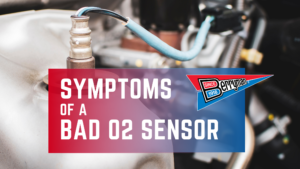We all dread the moment our vehicle begins to sound or perform suboptimally. This can often precede a trip to your mechanic or a deep search on the internet to self diagnose the car’s symptoms.
It’s important to keep your engine clean and your car running efficiently. If your car begins to stall or jerk, the culprits could be the O2 Sensors and the Catalytic Converter.
What is an O2 Sensor?
The O2 Sensor is a part of the emissions system that monitors and regulates the proportion of oxygen in the exhaust.

Symptoms of A Bad O2 Sensor
- The Check Engine Light Is On
- The check engine light is normally the first sign that something is not performing adequately. However, this light can indicate a number of mishaps that are not the only symptoms to look for to diagnose a sensor and converter issue.
- Bad Gas Mileage
- Any efficient driver will notice that the full gas tank is not lasting as long as it used to even though they are not driving more than normal. The average person drives about 12,000 miles per year, so an efficient mpg is essential. If you notice that you are spending more on fuel than normal, it could indicate a sensor failure.
- Emission Test Failure
- Sensor failure can account for the majority of emission test failure. Putting off fixing or replacing the sensor can result in many other repairs that need to be addressed.
- Rotten Egg Smell
- There could be a very unpleasant odor associated with a failing sensor, and no one wants to drive in a car that smells like rotten eggs.
- Rough Idling or Stalling
- If you are experiencing stalling or jerking when you are driving at a consistent speed, this could be a red flag that you need to replace your sensor.
Why is the O2 Sensor so Important?
It’s all about efficiency. When you have a failing sensor, your vehicle can lose up to 40 percent of its fuel efficiency. This means that the hard earned money you are using to fill up your gas tank will be wasted because your car is using too much gas.
This could also lead to engine failure which is a car repair that is far more expensive in most cases. Additionally, because the sensor deals with oxygen regulation, if it does not work properly, you could be exposed to carbon monoxide.
It is important to replace the O2 sensor sooner rather than later.
Can I Just Clean My O2 Sensor?
The short answer is that our strongest gasoline fuel additive, B-12 Chemtool Total Fuel System Clean-Up (part #2616), and a good tune-up might indirectly solve your problems.
However….
There are no true oxygen sensor cleaners that are safe to put through your engine. While some people choose to remove them and use a wire brush or an aerosol cleaner to remove deposits, we do not recommend trying to clean O2 sensors.
We feel their function is too critical to risk damaging the sensors and possibly (and erroneously) altering the air-fuel mixture. Additionally, the threads of the sensor(s) may not survive multiple removal and installation cycles. Sometimes they don’t even survive one complete cycle!
What About My Catalytic Converter?
As for the catalytic converter, you cannot directly clean one while it is still on the car, because anything that is safe to run through the engine will be converted to CO2, O2, and N2, none of which will do any cleaning. From that standpoint, a “catalytic converter cleaner” is gimmicky. Again, though, you do have some options.
Because catalytic converters are “self cleaning” under certain conditions, they should actually last the life of the car. If the “guts” are physically intact and there’s just some build up on the catalysts, you can:
- Run a high-performance fuel system cleaner like B-12 Chemtool Total Fuel System Clean-Up
- Get a Tune-Up
The combination of the two actions idealizes or “fixes” the combustion products and allows the catalytic converter to start burning/shaking off the deposits and becoming active again.
However, if the catalysts or the supporting structures are physically damaged, then nothing can be done to resurrect them. This can happen, for instance, as a result of prolonged unburned fuel exiting the combustion chamber due to old or bad spark plugs, broken spark plug wire, dirty combustion chambers, etc.
When this occurs, the catalytic converter can get too hot and start physically breaking apart over time. If this has happened, then no cleaner in the world can fix it, and the component will simply have to be replaced.
Conclusion
It’s for these reasons that our recommendation is two-fold. Using 2616 will clean fuel lines, fuel injectors, intake valves (in non-direct-injection motors), and combustion chambers. Then getting the vehicle tuned-up—paying particular attention to the ignition system, including the spark plugs and plug wires—will ensure you’re not allowing unburned fuel into the exhaust system.
After running the 2616 and getting the tune-up, you’ll need to do some extended driving of the vehicle, preferably on the highway or anywhere else you don’t have a lot of start-stop cycles, in hopes of burning off any deposits that have fouled the catalysts.
